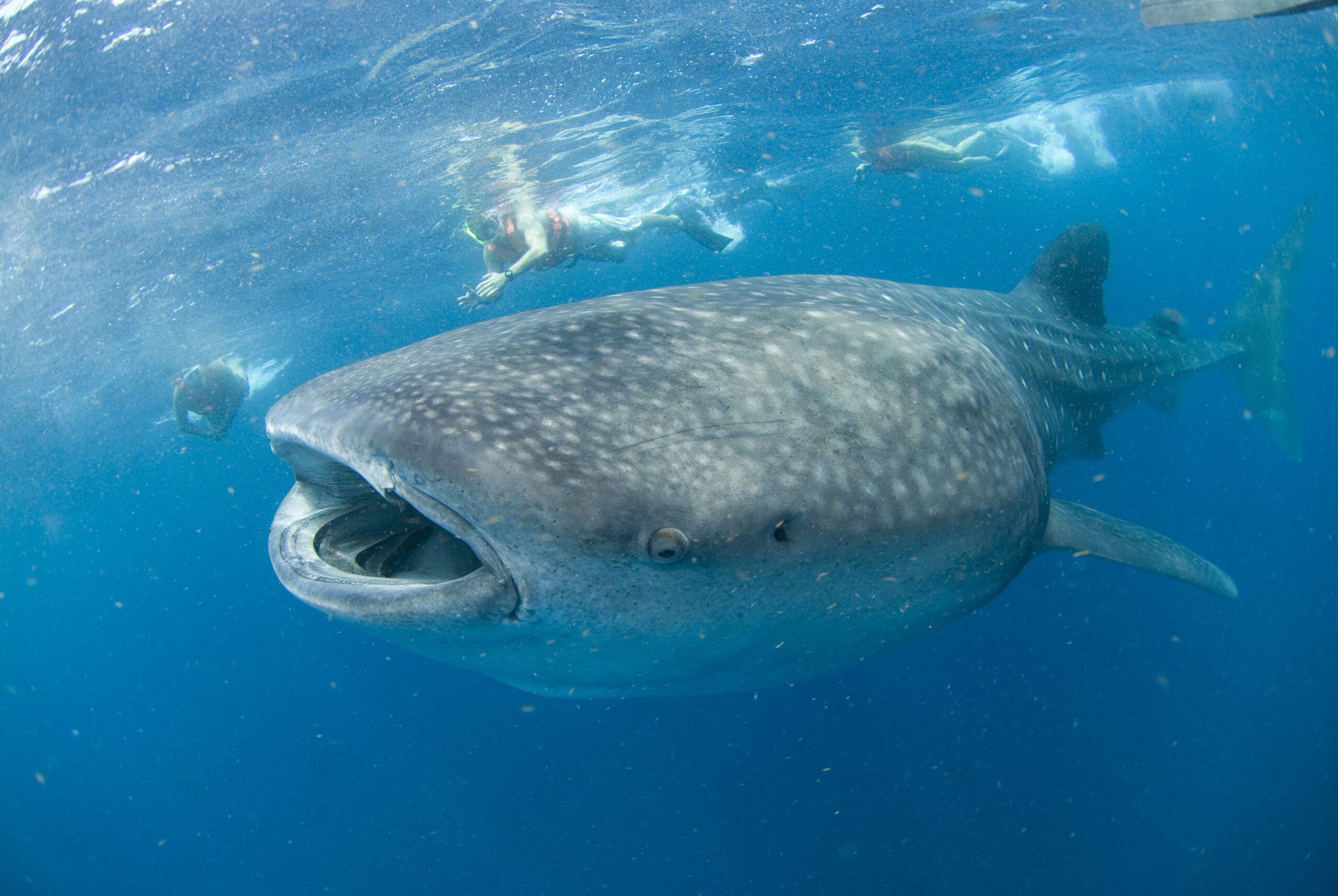One day, out on the water in his boat, floating around Holbox island, Kenneth Johnson* saw something beautiful happening; two whale sharks swimming side by side, like two teenagers out on a date. Johnson, the found of EcoColors and proud owner of a marine biology degree, was beside himself.
“We saw a male, maybe 33 feet long and a female, 30 feet long. So we said, ‘This is great. We’ll probably see them reproduce.’ We followed them like for three hours. They swam together, together, together, and then…they split up! Each one went swimming on their own.”
It takes a special person to invest most of his day following two whale sharks, hoping their love is real, but Johnson is that man. Twenty-six years ago, he left Mexico city with his wife Miriam and newborn son Ivan to start an eco-friendly tour in Quintana Roo. He spoke to me about the realities of running an ecologically minded business via phone and fully converted me to team whale shark.
Why whale sharks?
Johnson didn’t zero in on these gentle giants right away. At first, he wanted to capitalize on Cancun’s absolutely insane tourism industry.
According to Johnson, over four thousand tourists come to see the white sands and gorgeous surf of Cancun each year, though my research shows the numbers hit more than six thousand before the pandemic and are steadily climbing once again. Johnson and Miriam visited Costa Rica and saw a lot of the same attractions there as back home in Mexico.
“After we saw how they handled eco-tourism, I thought about Mexico; there’s so many places where you can do something like that. We were living in Mexico City and debating if we should (start a business) in Oaxaca or Michoacan, Chiapas. And we decided on Cancun. It has the second largest coral reef in the world, wetlands, a big jungle with a wide variety of wildlife and biodiversity, So we said let’s go to Quintana Roo.”
The couple arrived with their baby boy and explored different options when a friend let Johnson know he spotted a pod of whale sharks while he was out fishing. The two went out early the next morning and there they were; gigantic, bobbing blue beasts with wide, open mouths for all the delicious plankton at the surface
Johnson got his gear on and jumped into the water.
“It was just fantastic,” he said, “to see the whale sharks and to snorkel with them. Immediately, we wanted to develop a product for people to go see them.”
Is it safe to swim with whale sharks?
Whale sharks are an anomaly; they’re enormous. The longest on record measures 61.7 feet. They eat plankton, swim, and mate. And if you annoy them or cause them a moment’s stress, they’ll let you know by swimming straight down to a depth of the ocean that would cause you a lot of misery but suits them just fine.
Nothing the sharks do qualifies as dangerous.
That’s what Johnson’s first 200 customers discovered when he opened for business back in July 1997. Most tourists focused on the word shark and imagined floating in an underwater cage, not swimming next to nature’s biggest, nicest fish. It would take some time for people to get on board.
He had the same issue with guides. In Mexico, eco-tourism has three components; consideration of the environment, an educational component for tourists, and a benefit for locals in the area. Johnson helped out nearby fishers by offering them a job guiding tourists to whale pods.
But turning professional fishers into conservationists meant creating a huge cultural shift for the locals, a tremendous challenge.
“I mean, obviously,” Johnson said, “their way of life is their predatory. So, making this shift in their mind of, ‘No, we’re not going to fish them, we’re going to respect them. And we want to swim with them in a way that doesn’t impact them, so we need to have good environmental practices.”
Johnson and his new business, EcoColors, had to create a course that included practical exercises like taking the new guides out into the water and having them jump in next to a massive whale shark. Most of the guides got on board and saw how incredible a whale shark excursion job could be, not just for the environment but for their livelihood. But others immediately looked for loopholes that would, unfortunately, harm the whales or just drive them away, so Johnson had to hire carefully.
“It’s really complicated because some people get it and some people simply do not get it,” Johnson said.
Is swimming with whale sharks ethical?
While Mexico is a great place to be an eco-tourist, the government often bumps up against what conservationists want to see out in the wild. In the ocean, they want fewer boats.
But, one thing the Mexican government puts their foot down on is respecting applications. If a Mexican citizen jumps through all the bureaucratic hoops required to start an excursion business, he or she gets a permit, and there’s no maximum number of tours each year.
The water can get crowded fast, so Johnson encourages people to talk to each leader and make sure that person can offer some insight into the animals. If not, he recommends you keep looking.
One year, he explained, the government gave out 320 permits to individual whale shark tours, far too many to keep the animals safe. That number has since gone down, but Johnson wants to keep working with the coast’s governing bodies and help them balance profit and conservation.
“I try to be as open and as honest as I can,” Johnson said. “And I love the conservation world. And I’ve dealt with a lot of NGOs through the years who tell me, ‘You’re a for-profit company.’ Well, yeah, you know, without profit, we can’t survive.”
Johnson uses each tour as a class to educate people on how things like plastic waste and unsustainable living affect the ocean. His goal is to get people to make minor yet meaningful changes in their lives to help the ecosystem.
Is swimming with whale sharks worth it?
Johnson worked as a tour guide in the early years of EcoColors and got to see hundreds of people fall under the spell of whale sharks each summer. There’s something so humbling about swimming next to one of nature’s giants. Whale sharks don’t threaten people or animals thanks to a plankton-only diet. And they don’t have predators – whale shark meat is, as Johnson described it, “like soft tofu.”
And thank goodness for that, because it means the fishing boats that would normally pull them up for slaughter instead keep a friendly distance. They’re simply more fun to visit than to hunt. So, they swim, eat, and pair up while tourists swim nearby and pose for selfies, all without touching the whales, of course.
Johnson’s company EcoColors gets all kinds of tourists. When a group of 15 blind people got in touch with his company to organize a trip, he thought, Let’s do it.
“It was so fantastic because they didn’t see it the whale sharks but they felt them as they swam by. They knew the size of the whale sharks and how powerful they felt. They were saying, Oh, this whale shark was like 25 feet long! And they got it almost exactly right each time! But very, very close, you know. And it’s not only people have a unique experience, but our guides are captains also get these types of stories that are really nurturing. It makes you feel that you’re doing something good for people and the environment.”
Another visitor, a BBC reporter, went out to film the whale sharks for a story of his own. After he left the water, he confided in Johnson.
“He said, ‘I’ve filmed tigers, lions, anacondas. I’ve been in the war, but let me tell you; nothing is better than this.’”
Oh, and the whale shark couple from the top of the story? They got back together and swam off, hopefully to make more gigantic, gentle babies.
Learn more about the best eco-tourism in Mexico
See whale sharks, gorgeous beaches, and the best of Mexico on your next executive visit. Contact us here at Maritur DMC to swim with whale sharks and see other incredible eco-tours. We arrange all the details so you can enjoy your day while keeping yourself and Mother Earth safe.
Click here to get in touch.
*A big thanks to Kenneth Johnson and EcoColors for the photos and information for this article. Please check them out.












